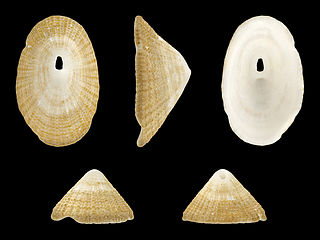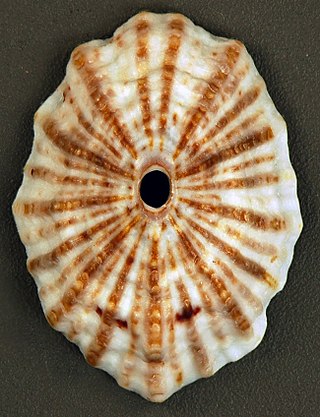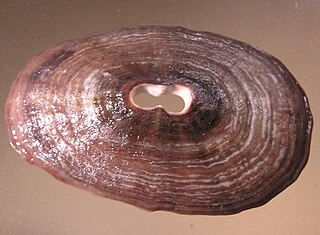
Hemocyanins (also spelled haemocyanins and abbreviated Hc) are proteins that transport oxygen throughout the bodies of some invertebrate animals. These metalloproteins contain two copper atoms that reversibly bind a single oxygen molecule (O2). They are second only to hemoglobin in frequency of use as an oxygen transport molecule. Unlike the hemoglobin in red blood cells found in vertebrates, hemocyanins are not confined in blood cells but are instead suspended directly in the hemolymph. Oxygenation causes a color change between the colorless Cu(I) deoxygenated form and the blue Cu(II) oxygenated form.
An immunogen is any substance that generates B-cell (humoral/antibody) and/or T-cell (cellular) adaptive immune responses upon exposure to a host organism. Immunogens that generate antibodies are called antigens ("antibody-generating"). Immunogens that generate antibodies are directly bound by host antibodies and lead to the selective expansion of antigen-specific B-cells. Immunogens that generate T-cells are indirectly bound by host T-cells after processing and presentation by host antigen-presenting cells.

The Patellogastropoda, common name true limpets and historically called the Docoglossa, are members of a major phylogenetic group of marine gastropods, treated by experts either as a clade or as a taxonomic order.

Fissurellidae, common name the keyhole limpets and slit limpets, is a taxonomic family of small to medium-sized limpet-like sea snails, marine gastropod molluscs in the clade Vetigastropoda.

Diodora cayenensis, the Cayenne keyhole limpet, is a species of small to medium-sized sea snail or limpet, a western Atlantic marine prosobranch gastropod mollusk in the family Fissurellidae, the keyhole limpets.

Keyhole limpet hemocyanin (KLH) is a large, multisubunit, oxygen-carrying, metalloprotein that is found in the hemolymph of the giant keyhole limpet, Megathura crenulata, a species of keyhole limpet that lives off the coast of California, from Monterey Bay to Isla Asuncion off Baja California.

Vetigastropoda is a major taxonomic group of sea snails, marine gastropod mollusks that form a very ancient lineage. Taxonomically the Vetigastropoda are sometimes treated as an order, although they are treated as an unranked clade in Bouchet and Rocroi, 2005.

Fissurella volcano, commonly named the volcano limpet or volcano keyhole limpet, is a species of small to medium-sized sea snails, marine gastropod mollusks in the family Fissurellidae, the keyhole limpets. Like other members of the keyhole limpet family, the volcano limpet is not considered a "true" limpet.

Diodora aspera, also known as the rough keyhole limpet, is a species of sea snail, a marine gastropod mollusk in the family Fissurellidae, the keyhole limpets. Although similar in appearance to a common limpet, it has a hole near the apex of its shell, and is only distantly related. It often has a scaled polychaete worm Arctonoe vittata living inside its shell as a commensal. In the event that it is attacked by a starfish, it extends flaps of mantle to defend itself, and the worm also helps drive the predator away.
Diodora canariensis is a species of sea snail, a marine gastropod mollusk in the family Fissurellidae, the keyhole limpets.

Diodora funiculata is a species of sea snail, a marine gastropod mollusk in the family Fissurellidae, the keyhole limpets.

Fissurella barbadensis is a species of limpet in family Fissurellidae, the keyhole limpets. It is known commonly as the Barbados keyhole limpet and the rugose slit limpet. This species is native to the western Atlantic Ocean, including many islands of the Caribbean.

Puncturella exquisita is a species of sea snail, a marine gastropod mollusk in the family Fissurellidae, the keyhole limpets.

Diodora jukesii, common name Jukes' keyhole limpet, is a species of sea snail, a marine gastropod mollusk in the family Fissurellidae, the keyhole limpets and slit limpets.
Puncturella cucullata, common name the hooded keyhole limpet, is a species of sea snail, a marine gastropod mollusk in the family Fissurellidae, the keyhole limpets and slit limpets.

Puncturella pelex is a species of sea snail, a marine gastropod mollusk in the family Fissurellidae, the keyhole limpets and slit limpets.
Puncturella cumingii is a species of sea snail, a marine gastropod mollusk in the family Fissurellidae, the keyhole limpets and slit limpets.

Fissurella crassa, common name the thick keyhole limpet, is a species of sea snail, a marine gastropod mollusk in the family Fissurellidae, the keyhole limpets and slit limpets.

Fissurella virescens, also known as the green Panama keyhole limpet, is a species of sea snail, a marine gastropod mollusk in the family Fissurellidae, the keyhole limpets and slit limpets.

The Diodorinae, common name keyhole limpets and slit limpets, is a taxonomic subfamily of limpet-like sea snails, marine gastropod molluscs in the family Fissurellidae, the keyhole limpets and slit limpets.

















